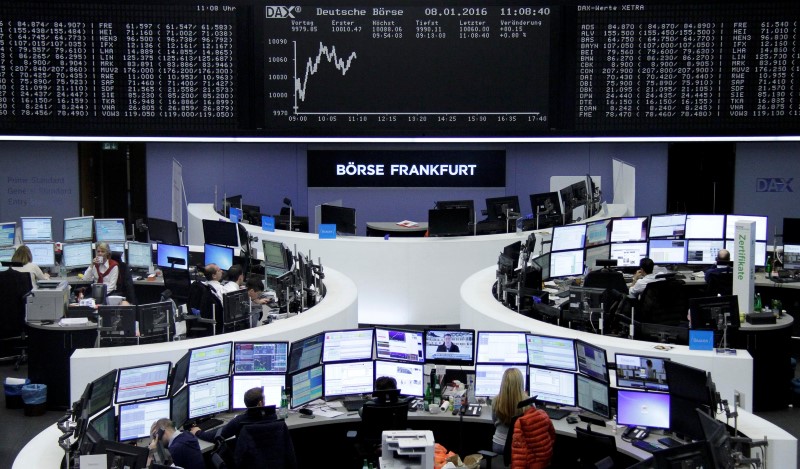By Marc Jones
LONDON (Reuters) - Gains by Chinese stocks, a steadier yuan and a recovery in oil prices helped calm frazzled investors on Friday, just in time for the first U.S. payrolls report of the year.
China nudged the yuan higher for the first time in nine days, easing fears that it had lost control of the currency. Traders also cheered its decision to dump an unpopular stock market "circuit-breaker" system introduced this week, helping to restore a measure of risk appetite.
After a 10 percent-plus drop in Chinese equities, an equally dramatic slump in oil and major volatility in other markets, a 2 percent rise by Chinese .CSI300 shares ensured Asia end higher for the first time in 2016.
Europe initially followed suit, with the FTSE, DAX and CAC40 up as much as 0.5 percent, but they later gave up their gains. Wall Street futures point to a near 1 percent bounce on the S&P 500 and Dow Jones Industrial after what been their worst-ever start to a year.
The nightmare last four days has meant Asia has seen its biggest weekly fall since the euro zone crisis in 2011, and Europe and the 46-country MSCI All World index dropped the most since China's first yuan devaluation last August.
"I think there will be a bit of a stabilization now," said Didier Duret, chief investment officer at ABN Amro. "This is more of an echo of the crisis we had in August rather than a replay because it lacks some of the surprise element.
"It created a lot of volatility and turmoil, but hopefully now global markets can regain their composure."
It all came just in time for some of the most influential pieces of macroeconomic data for markets, the monthly U.S. non-farm payrolls figures and the first since .
The latest Reuters poll shows economists expect 200,000 jobs were added last month and the overall unemployment rate remained at a 7 1/2-year low of 5 percent.
A solid report could soothe fears over the economy's health by showing recent weakness was largely restricted to manufacturers and exporters. Both have been hit by a strong dollar and anemic global demand.
It will also be the first reading since the Federal Reserve raised U.S. interest rates last month for the first time in almost a decade.
ON THE JOBS
There was also a sense of relief in commodities markets as oil prices pulled out of their tailspin, although few experts were willing to declare an end to the slump.
After reaching a 12-year low the previous session, Brent crude rose as high as $34.72 a barrel and U.S. West Texas Intermediate $34.34 a barrel before both starting to backslide again.
When U.S. investment bank Goldman Sachs (N:GS) said last year that oil could fall as low as $20 per barrel, it assigned a fairly low probability to that scenario.
Fast-forward five months and in some parts of the world the forecast has already proved correct. Canadian physical crude has been selling this week at below $20 per barrel, less than it costs to extract and transport.
And proving just how much the ground is shifting in the oil market, Saudi Arabia's deputy crown prince, Mohammed bin Salman, said on Thursday that the government was weighing up selling shares in state oil giant Saudi Aramco.
Industrial metals like copper, iron ore and zinc were also steadier after losses of 4 to 6 percent so far this week, while gold was one of several safe-haven assets to retreat.
Amid hopes for a solid payrolls number and relief over the steadying of the yuan, the dollar rose more than half a percent against both the euro to $1.0869 and yen to 118.34 yen.
The yen, the currency market's safe-haven darling, has been one of the major beneficiaries of this week's turbulence. It gained roughly 1.7 percent against the dollar and 1.5 percent versus the euro.
Friday's turnaround came after China's central bank nudged the yuan/dollar rate up to 6.5636 per dollar. On Thursday, it reportedly had intervened to defend the yuan in offshore trade, reversing a decline of more than 1 percent that took it to a record low of 6.7600 per dollar.
The PBOC's Friday setting is "a signal it does not intend to keep allowing the yuan to fall," said Yoshinori Shigemi, global market strategist at JPMorgan (N:JPM) Asset Management.
Elsewhere in Asia, Japan's Nikkei surrendered earlier gains to end the day at its lowest since Sept. 30. That extended losses for the week to 7 percent, the biggest weekly decline in four months.
In bond markets, yields on 10-year U.S. Treasuries fell to a 2 1/2-month low of 2.119 percent on Thursday and last stood at 2.17807 percent. German Bunds were steady at 0.539 after their yields fell this week as investors headed into safe assets.
"The fact that 10-year German yields are back at around 50 basis points shows there is a flight to quality," said Martin van Vliet, senior rates strategist at ING.
Though much could depend on the 1330 GMT payrolls figures, Wall Street, which opens at 1430 GMT, was expected to see a small bounce after a five percent fall this week.
Before the U.S. market open, Taiwan's Hon Hai Precision Industry Co became the latest Apple (O:AAPL) supplier to feed worries about iPhone sales as it reported a 20 percent slump in December revenues.
